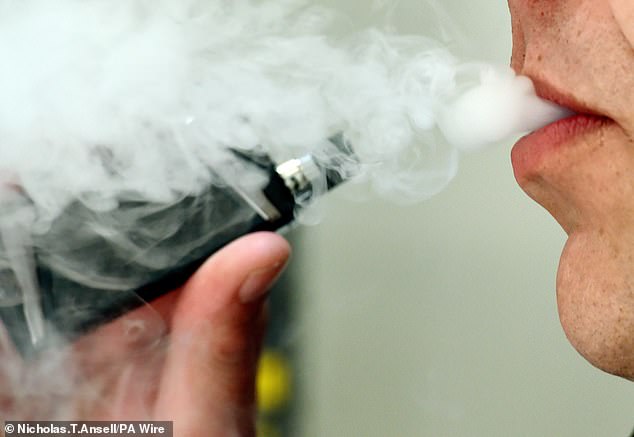The number of young adults vaping triples in two years as nicotine use rises but smoking continues to fall, study shows
The number of 18 to 24-year-olds vaping has tripled in two years, driven by the rise of disposable devices, a study has found.
Researchers from University College London examined vaping and smoking data for 132,252 people in England from 2016 to May last year.
They found that while smoking continues to decline among all ages, vaping increased, especially among those under 25, with the share saying they vaped rising from 9 percent in May 2021 to 29 percent in May 2023.
It meant that overall nicotine use rose from 28 percent to 35 percent, which was due to the popularity of disposable vapes.
Dr. Ian Walker – executive director of policy at Cancer Research UK, which funded the study – said: ‘This shows a worrying increase in the number of young adults using vapes since disposables became available in the UK.’
Researchers from University College London have found that the number of 18 to 24 year olds vaping has tripled in two years, driven by the rise of disposable devices (file pic)

Vaping can expose teens to toxic metals that can damage the brain and other vital organs, with the risk being even greater with sweet flavors of e-cigarettes
The rising number of people vaping coincides with another study showing that it can expose teens to toxic metals that can damage the brain and other vital organs.
The risk could be even greater with sweet flavors of e-cigarettes, which are generally preferred by young people.
Experts say the findings underscore the need for stronger regulations and prevention efforts to stop the targeting of teens.
The analysis involved 200 American teens, ages 13 to 17, who were categorized as frequent, intermittent or occasional vapers.
Usage was determined by the average number of puffs per day, ranging from 27 puffs, 7.9 and 0.9 puffs, respectively.
Biomarkers in the urine were then assessed for the presence of the metals lead, uranium and cadmium.
Both frequent and intermittent e-cigarette users had higher lead levels in their urine than those who vaped occasionally, the study found.
Frequent vapers also had higher levels of uranium in their urine compared to occasional users.
Different vape flavors affected uranium levels, according to the findings published in Tobacco Control.

Experts say the findings underscore the need for stronger regulations and prevention efforts to stop the targeting of teens (file photo)
A third of vapers preferred menthol or mint flavors, while 49.8 percent used fruit-flavored vapes and 15.3 percent used sweet-flavored vapes.
According to researchers, those who used sweet-flavored vapes had higher uranium levels compared to those who preferred menthol or mint.
Researchers acknowledged the study’s limitations, including that the presence of uranium in urine could be due to environmental exposure or dietary intake.
However, they said: ‘Despite the limitations, this study reported increased urinary lead and uranium levels associated with vaping frequency.
‘Sweet flavors can pose an additional risk for uranium exposure.
‘Using e-cigarettes during adolescence can increase the risk of exposure to metals, which can negatively impact brain and organ development.
‘These findings call for further research, regulation of vaping and targeted public health interventions to limit the potential harms of e-cigarette use, especially among adolescents.’
Professor Lion Shahab, co-director of the UCL Tobacco and Alcohol Research Group, said: ‘This is a well-conducted study that underlines the need to carefully monitor exposure in e-cigarette users and highlights the fact that e-cigarettes are not without risk are. and therefore should not be used by people who have never smoked, especially by adolescents.’
However, he said the findings must be taken in context, including the fact that uranium exposure can come from a number of sources.
There was also no control group of teens who don’t vape included in the analysis, he said.
Professor Shahab added: ‘This study therefore cannot tell us anything about the absolute increase in heavy metal exposure from e-cigarette use in this population, only about the relative exposure among fewer and more frequent e-cigarette users.
‘Given that exposure to heavy metals is mainly determined by the type of device used, future studies should investigate whether there are meaningful differences between different types of e-cigarettes to inform regulators to reduce the use of devices that expose users to limit more heavy metals.
‘The relatively small sample size in this study did not allow this topic to be explored.’
A report published last June by Action on Smoking and Health (Ash) found that 20.5 percent of children in Britain had tried vaping in 2023, up from 15.8 percent in 2022 and 13.9 percent in 2020.
The government’s Tobacco and Vapes Act, announced in October, aims to create a smoke-free generation by banning the sale of tobacco to people born on or after January 1, 2009.
It will also crack down on vaping in a bid to reduce its appeal to children and young people.
Proposals could include restrictions on how vapes are displayed in stores, as well as restrictions on flavors and packaging.
